#Heledd Gwynn
Photo










The Tempest || Feature trailer
#alex kingston#the tempest#jessica rhodes#heledd gwynn#alex kingston edit#long post#so yeah. I guess they recorded it & they'll release sooner or later#dwcast edit#anyway. at this point the rsc should pay me for making content#hoNESTLY#mine
52 notes
·
View notes
Text
Storm in a Recycled Cup
THE TEMPEST
Royal Shakespeare Theatre, Stratford upon Avon, Monday 6thFebruary 2023
There is a welcome drive in contemporary theatre for sustainability and being green. The RSC is at the forefront: they’ve been recycling the same 37 plays for decades! Seriously, anything that reduces or offsets an organisation’s carbon footprint can only be for the good, can’t it? Can this example of…

View On WordPress
#Adrienne Quartly#Alex Kingston#Cath Whitefield#Elizabeth Freestone#Heledd Gwynn#Ishia Bennison#Jessica Rhodes#Joseph Payne#Peter de Jersey#review#Royal Shakespeare Theatre#RSC#Simon Startin#The Tempest#Tom Piper#Tommy Sim&039;aan#William Shakespeare
4 notes
·
View notes
Text
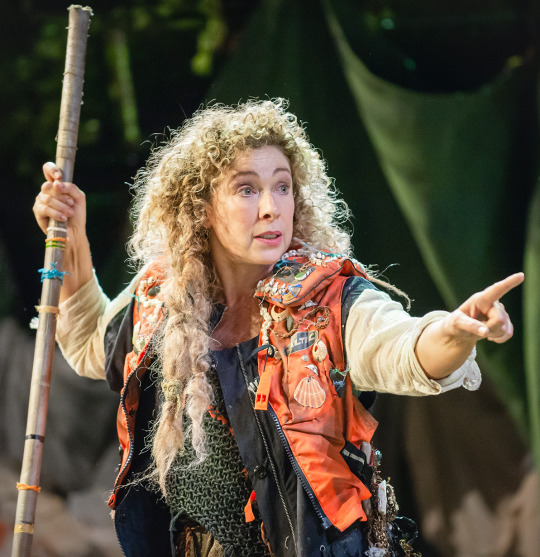


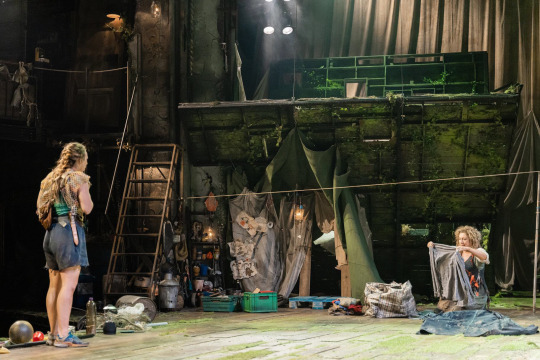
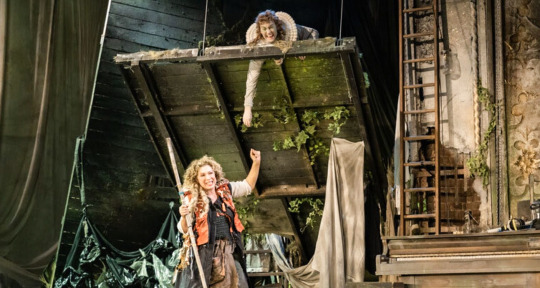
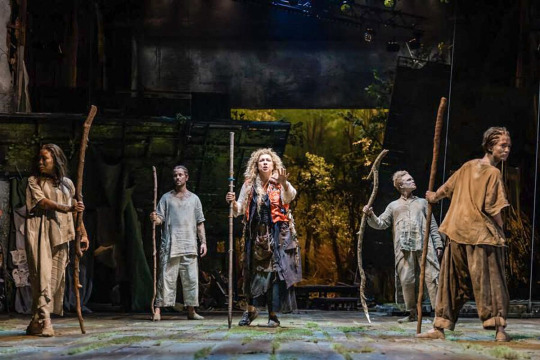
REVIEW: THE TEMPEST: Alex Kingston is a magnificent Prospero
Royal Shakespeare Company, Stratford-upon-Avon
If there were prizes for inventive recycling of props, this RSC staging would get the soup-tin statuette. Oil drums are rolled to illustrate anecdotes, drunkards quaff from petrol cans and Ariel’s flute is twisted together from plumbing pipes. With references to “the quality of the climate” and “mutinous winds”, The Tempest sustains director Elizabeth Freestone’s contemporary interpretation with little strain, helped by the opening storm being made by man. Or, in this version, woman. Alex Kingston’s Prospero, though still an exiled “duke” of Milan, is mother to a daughter. This affects the text, neutralising Shakespeare’s “farther” puns and forcing recounts in Miranda’s lines about how many men she saw before Sebastian, while Prospero’s rather creepy concern with the security of Miranda’s hymen feels unlikely from a bohemian modern mother. Gender-stubbornness about Shakespearean roles would have robbed us of great Lears from Glenda Jackson and Kathryn Hunter, and also of Kingston’s magnificent, revelatory Prospero. “Our revels now are ended” and “this rough magic I here abjure”, the soliloquies disavowing super-powers, are often played as elegiac farewells, but from Kingston feel closer to Christ at Gethsemane, a war between two natures. This Prospero rages against the dying of her might. Heledd Gwynn’s Ariel, hair and makeup channelling Aladdin Sane, is alternately punchy, touching and tuneful until a spectacularly athletic exit. A very modern staging that is fundamentally true to the text and the RSC’s intellectual, rigorous, clear-speaking traditions. At the Royal Shakespeare theatre, Stratford-upon-Avon, until 4 March.
#Alex Kingston#Kingston Edit#Royal Shakespeare Theatre#Shakespeare#The Tempest#Threatre#2023#Royal Shakespeare Company#Threatre Review#OMG It's Moll Hair 😍
42 notes
·
View notes
Text

Ilaera Llewellyn Headcanons
Thought I'd post these for funsies! Both SFW and NSFW headcanons below the cut.
Ilaera is a polyglot. She grew up learning Welsh, as Wales was her home country, but is fluent in Irish Gaelige as well. Her French is passable - enough to get by when her photos were being shown in galleries in Paris, anyway. As a seduction technique, it has proven popular both in life and in Hell - everyone loves a nice accent, too.
Though she experimented on both herself and others in the name of art, the scars left behind on her are a point of ambivalence, even to herself. Some days she is prideful of them, pleased that the remnants of her art are displayed for all of Hell to see. Other days she hides them away beneath sleeves and layers. However, no matter what she feels about the scars on her torso on any particular day, the lightning scars on her demonic form never bother her. The eternal bruising and discoloration on her neck is another story- that is almost always covered one way or another.
For the first 2 years of Ilaera’s career as a photographer, though she longed to push the limits of the craft, she stuck to what was acceptable. her favourite subject was always people - the beauty of the body, in all its forms. Later, she was able to push boundaries, venturing more into the macabre. Sometimes she used herself as a subject, fascinated by the fact that no matter who was under the lights, they all bled the same way.
Ilaera displays some some narcissistic traits as well as APD traits.
Ilaera is a very physical person - though she prefers to be alone romantically, she still craves touch, and near constantly seeks out one night stands - or “dalliances” as she calls them. She is slightly hypersexual.
Ilaera grew up during WW2 in the U.K, and as a result now has claustrophobia from sitting in bomb shelters, sometimes for days. She detests elevators and will always choose stairs if they’re available.
She enjoys sewing, gardening and running. Sewing is helpful for stitching, which she often had to do for her… art. She also enjoyed growing various poisons and paralytics. Also helpful for her art.
Ilaera has never once wanted a romantic relationship with anyone - she is physically attracted to a wide variety of people (now sinners), but getting entangled with feelings has never been something she has sought.
She’s a decent dancer - nothing extraordinary, but enough to look good when she goes out for a night on the town.
Other than alcohol, Ilaera doesn’t mess with mind-altering things. She prefers to keep a clear head, though now that she’s in Hell and doesn’t have to keep constant awareness, she’s rather curious about some of the substances she’s seen others partake in.
As many egomaniacs do, Ilaera hates admitting any weakness. The claustrophobia, her nightmares, her fear of Extermination, even the bruising around her neck - she hides it all away.
Her voice claim is Heledd Gwynn.
NSFW Ilaera Headcanons
Is absolutely the definition of a switch. Everything depends on her partner, though she tends to lean towards subbing with men and domming with women, though that's just based on her own experience with sex in the 50s.
She loves control, but also loves people to fight her for it.
Bratty when she subs. Give this woman a good round of bantering and she'll be on you like beans on toast.
Absolutely a "try anything once" kind of gal. But she knows what she likes, and isn't afraid to draw hard boundaries.
One night stands are very much her thing. She hates forming any kind of attachment, hates relying on anyone, so ONS are best, as long as they're with someone as experienced as she is.
Enjoys both sides of sadomasochism. Giving or receiving, pain is one of her favourite activities.
Very much enjoys marking.
Before death, she enjoyed getting choked out - not so much now. She will all but freak out if her neck is touched.
Somewhere between a C and D cup, sizable thighs, a full/curvaceous middle. She's thick all over. Lots to grab onto.
Doesn't mind degradation, but she will never beg.
Somewhat hypersexual.
Will add more as I think of them!
0 notes
Photo





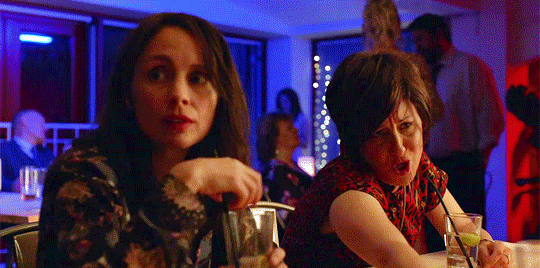
The Pact (2021) - 1x01
#thepactedit#the pact#tp cat#tp tish#louie evans#anna price#heledd gwynn#abbie hern#eiry thomas#laura fraser#the pact spoilers#the pact 1x01#femslash related stuff#cat x trish#:D#I KNEW from just how focused cat was on trish#I love when it's so clearly telegraphed#and light friendly teasing too#and they ended up being very cute
81 notes
·
View notes
Photo










THE PACT (2021)
#bbc the pact#the pact bbc#wlwedit#lgbtedit#Heledd Gwynn#Abbie Hern#(mine)#sweet and ultimately happy voule-vous :)#tish surprisingly turned out to be real ride or die for cat didn't she
2 notes
·
View notes
Photo



8 notes
·
View notes
Text
Abbie Hern as Tish



The actresses stars in the drama series The Pact.
#the pact#tish x cat#abbie hern#lgbt#black lgbt#queer characters#black queer characters#lavandnoir#bbc#heledd gwynn#black lgbt characters#lgbt characters
0 notes
Video
youtube
The Pact - Official Trailer (2022) Laura Fraser, Julie Hesmondhalgh, Eiry Thomas, Heledd Gwynn
1 note
·
View note
Text
Is 'The Pact' Based On A True Story?

Coming to BBC One this month is The Pact, a brand new thriller centred on a difficult moral dilemma. Airing on Monday, May 17, the six-part series sees four friends and brewery workers, Anna, Nancy, Louie, and Cat, bound by a secret after the body of their new boss is discovered in the woods — as you’d expect, their lives are never the same again. Starring Julie Hesmondhalgh and Laura Fraser, the thriller asks what really happened that night in the woods but, is The Pact based on a true story?
The Pact was penned by Doctor Who and Wentworth writer Pete McTighe and isn’t based on a true story (which, by the looks of the plot, is a good thing), but it will deal with some very realistic emotions and relationships. Also starring Eiry Thomas and Heledd Gwynn, the series will see the four women deal with the chain of events following their antagonistic boss’ unexpected death and the struggle to keep their weighty secret hidden.
In a statement released by BBC, McTighe revealed that he was heavily influenced by “female ensemble dramas” and was keen to write a “complex” female-led drama series. “After finishing a prison drama that ran for 8 years [Wentworth], I was craving something different – something just as characterful and surprising, but less claustrophobic and with its own strong identity,” he said.
For The Pact, McTighe promises an exciting thriller but also emphasises that the series is intended to go beyond that.
“The Pact is a show that explores secrets and their consequences,” he states. “Yes, it’s a thriller, with big twists and surprises, but first and foremost it’s a character piece – so it was important to me to take time to drill down into each of our key characters and properly explore the impact of a terrible moral dilemma on each one.”
The new series was filmed across various locations in Wales late last year, during much of the pandemic and the second lockdown, however, the series is set in a non-COVID world.
“It was also important to me that the show provided some relief from the pandemic we are all living through, but it didn’t feel right to ignore what we’ve all experienced this past year,” McTighe went on to explain.
He added: “So, our story is set slightly in the future, where most of the population is vaccinated and life is returning to ‘normal’ – but for our characters, the stress and anxiety of 2020 and the various lockdowns has cast a psychological shadow that informs some of their behaviour and decisions.”
The Pact airs on BBC One on Monday, May 17 at 9 p.m.
Get More Dating Advice Here
0 notes
Text
Is 'The Pact' Based On A True Story?

Coming to BBC One this month is The Pact, a brand new thriller centred on a difficult moral dilemma. Airing on Monday, May 17, the six-part series sees four friends and brewery workers, Anna, Nancy, Louie, and Cat, bound by a secret after the body of their new boss is discovered in the woods — as you’d expect, their lives are never the same again. Starring Julie Hesmondhalgh and Laura Fraser, the thriller asks what really happened that night in the woods but, is The Pact based on a true story?
The Pact was penned by Doctor Who and Wentworth writer Pete McTighe and isn’t based on a true story (which, by the looks of the plot, is a good thing), but it will deal with some very realistic emotions and relationships. Also starring Eiry Thomas and Heledd Gwynn, the series will see the four women deal with the chain of events following their antagonistic boss’ unexpected death and the struggle to keep their weighty secret hidden.
In a statement released by BBC, McTighe revealed that he was heavily influenced by “female ensemble dramas” and was keen to write a “complex” female-led drama series. “After finishing a prison drama that ran for 8 years [Wentworth], I was craving something different – something just as characterful and surprising, but less claustrophobic and with its own strong identity,” he said.
For The Pact, McTighe promises an exciting thriller but also emphasises that the series is intended to go beyond that.
“The Pact is a show that explores secrets and their consequences,” he states. “Yes, it’s a thriller, with big twists and surprises, but first and foremost it’s a character piece – so it was important to me to take time to drill down into each of our key characters and properly explore the impact of a terrible moral dilemma on each one.”
The new series was filmed across various locations in Wales late last year, during much of the pandemic and the second lockdown, however, the series is set in a non-COVID world.
“It was also important to me that the show provided some relief from the pandemic we are all living through, but it didn’t feel right to ignore what we’ve all experienced this past year,” McTighe went on to explain.
He added: “So, our story is set slightly in the future, where most of the population is vaccinated and life is returning to ‘normal’ – but for our characters, the stress and anxiety of 2020 and the various lockdowns has cast a psychological shadow that informs some of their behaviour and decisions.”
The Pact airs on BBC One on Monday, May 17 at 9 p.m.
Get Relationship Advice Here
0 notes
Text
Welsh poetry - Wikipedia
Welsh poetry may refer to poetry in the Welsh language, poetry in English from Wales, or other poetry written in Wales or by Welsh poets.
History[edit]
Wales has one of the earliest literary traditions in Northern Europe, stretching back to the days of Aneirin (fl. 550) and Taliesin (second half of the 6th century), and the haunting Stafell Cynddylan, which is the oldest recorded literary work by a woman in northern Europe.[citation needed]
The 9th century Canu Llywarch Hen and Canu Heledd are both associated with the earlier prince Llywarch Hen.
Welsh poetry is connected directly to the bardic tradition, and is historically divided into four periods.[1] The first period, before 1100, is known as the period of Y Cynfeirdd ("The earliest poets") or Yr Hengerdd ("The old poetry"). It roughly dates from the emergence of the Welsh language from Common Brittonic in the sixth century to the arrival of the Normans in Wales towards 1100. The second period, the period of the "Poets of the Princes" (Beirdd y Tywysogion, also called Y Gogynfeirdd), lasted from about 1100 until 1350, or until 1282, the date of the overthrow of Llywelyn. The final classical period of Welsh poetry, referred to as the period of the Poets of the Nobility (Beirdd yr Uchelwyr) or simply Cywyddwyr, lasted from 1350 to 1600. These included Dafydd ap Gwilym and Iolo Goch, and they produced many cywyddau. There was a lull in the production of poetry after the union with England in the 16th century. The year 1600 is generally taken to mark the beginning of modern Welsh poetry.
Throughout this time, serving as a bard was one of the few ways that one might better oneself socially, by becoming either a chief poet or a household poet.[1] Both of these categories of bards could achieve status through a grading system, with the lowest being a minstrel (who was technically an ungraded bard), the lowest graded status of a disciple, a graduated disciple of poetry, a disciplined disciple, a disciple of chief-poet-craft, and finally a chief poet.[2]
The earliest poem in English by a Welsh poet dates from about 1470. More recently, Anglo-Welsh poetry has become an important aspect of Welsh literary culture, as well as influencing English literature.
The works of the great hymn writers of the 18th and 19th centuries are also poetic: in particular William Williams Pantycelyn and Ann Griffiths. Around 1900, there was a renaissance with poets such as T. Gwynn Jones. Other notable writers were T. H. Parry-Williams and D. Gwenallt Jones; and around 1950 others such as Waldo Williams. Many poets in the late 20th century produced work of a high standard, many of them in cynghanedd.
Welsh poets often write under bardic names to conceal their identity in Eisteddfod competitions.
Since the later Middle Ages, the traditional Welsh poetic metres in strict verse consist of twenty four different metrical forms written in cynghanedd, something unique to Welsh language poetry.
An awdl is a form of long poem, similar to the ode. The most popular metrical forms are the Cywydd, of 14th-century origin, and the several versions of the Englyn, a concise and allusive verse form similar to the Greek epigram and the Japanese haiku and as old as Welsh literature itself.
See also[edit]
References[edit]
^ a b Loesch, K. T. (1983). Welsh bardic poetry and performance in the middle ages. In D. W. Thompson (Ed.), Performance of Literature in Historical Perspectives (177–190). Lanham, MD: University Press of America.
^ Parry, T. (1929). Statud Gruffudd ap Cynan. Bulletin of the Board of Celtic Studies, 5(1), 29-33.
External links[edit]
0 notes
Text
Y Fenyw a Ddaeth o’r Môr
Ar Ddydd Llun y 16eg o Fawrth, 2015 am 7.30yh, roedd perfformiad o ‘Y Fenyw a Ddaeth o’r Môr’ sef y ddrama wreiddiol gan Ibsen ‘The Lady from the Sea’ yn Theatr y Ffwrnes, Llanelli. Cyfieithiad Cymraeg o ddrama Ibsen gan Menna Elfyn a pherfformiwyd gan Theatr Genedlaethol Cymru.
Pan eisteddwyd yn fy set i ddechrau gwylio'r perfformiad, roedd y set yn wag ond roedd yna ddefnydd o liwiau megis glas a gwyn. Lliwiau nid yn unig oedd yn cyfleu’r môr ond hefyd yn ychwanegu rhyw ddirgelwch cyn dechrau'r perfformiad ac yn sicr yn ychwanegu ias i'r gynulleidfa o’r hyn oedd i ddod.
Drama ydyw yn sôn am ddyhead Elida Wanger sef merch i geidwad y goleudy am gael rhyddid. Mae’r ddrama wedi ei leoli o amgylch tiroedd Norwy. Roedd yr actio yn wych gan Heledd Gwynn a wnaeth portreadu'r cymeriad yn dda iawn. Mae Elida yn gaeth mewn priodas ac yn gweld ei hun yn gorfod dewis pa fywyd fyddai orau iddi, bywyd syml gyda’i gwr neu ddewis bywyd llawn cyffro ar lan y môr.
Yn sicr, roedd yn berfformiad hynod o drawiadol ac roedd yn sicr wedi dangos sut awdurdod oedd gan Elida i wneud y penderfyniad dros ei hun ond hefyd wrth ei wylio yr oeddwn fel cynulleidfa yn gallu cymryd agweddau o gymeriad Elida ai perthnasu gyda menywod eraill o fewn cymdeithas.
0 notes